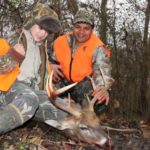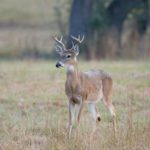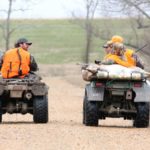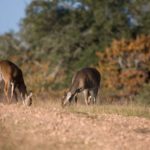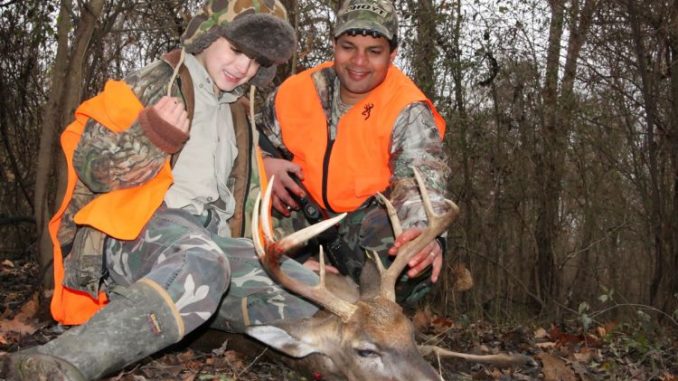
Deer activity always crashes at some point in the season, so what’s a die-hard hunter to do? These tested buck killers say it’s just a matter of making key adjustments.
The dog days of summer have nothing on the dog days of December.
Anybody fishing during the dog days of summer knows before launching his boat that tough fishing lies ahead.
The dog days of December arrive with a lot less fanfare and a lot more frustration because deer hunters expect deer to be moving.
But something happens between the first early flush of activity accompanying bow season and youth weekend, and the lull that sets in sometime before the rut.
Of course, the timing of this reduction in activity is entirely dependent upon when rut starts in your area. If you’re hunting post-rut deer this December, consider yourself lucky and focus on food sources while bucks recover.
If your rut doesn’t start until late December or January, consider yourself lucky you get to sit in a deer stand, but be prepared to sit a while — maybe a long while.
It’s pretty easy to tell when the lull hits your particular neck of the woods: Deer still stuck in their summer patterns and moving about with carte blanch impunity suddenly get hip to the deal that there is something awry in the woods.
Then all bets are off until the rut arrives.
But that doesn’t mean hunters have to go home empty-handed.
In fact, Bassmaster Elite Series anger Dennis Tietje spends his time going from bass fishing to deer hunting this time of year — and he frequently finds himself hunting the lull, whether he’s near his home in Southwest Louisiana or up in Winn Parish.
Tietje dropped a 150-pound 8-point back in October hunting the lull in Winn Parish.
“Big-time lull,” he bemoaned. “They weren’t moving anyway, but the heat had them shut down even more, and the acorns were hitting the ground.
“They didn’t have any reason in the world to move.”
The rut doesn’t kick off in Winn Parish until sometime the week before to the week after Thanksgiving, so the lull in deer movement happens much of October and early November.
But back in Southwest Louisiana, where deer were already chasing in late October, the lull happens a lot earlier.
No matter when it happens, the fact that the lull does happen is something deer hunters have to take into account whether their deer rut in November, December, or January.
And learning from those who have already made it through these trying times and come out the other side with a deer or two in their hip pockets can pay off for those suffering through right now.
Why it happens
Tietje believes a few converging factors collide to create the lull.
“It’s almost like they become dormant,” he said. “Even our game cameras don’t have a lot of pictures on them during the lull.
“Pressure in the woods is a big part of it, but so is the fact that they’re just not ready to chase and the woods are full of food sources so that when they do get up to feed they don’t have to go very far.”
As for the buck Tietje just shot in Winn Parish, he said he was fortunate enough to be set up next to its bedding area, and the deer just happened to step out right at dark.
That’s where Tietje’s No. 1 tip for hunting the lull comes into play — being mobile.
“It would make sense to hunt close to bedding areas, but the problem with that is getting in and out undetected,” he said. “I think it’s best to move to the major food source and hunt it versus the bedding areas.
“And that doesn’t necessarily mean hunting a food plot. In fact, I would stay off the plots during the lull.”
Go grocery shopping — early
To follow Tietje’s advice, hunters with box or ladder stands surrounding food plots should invest in quality climbing stands so they can find productive white oak trees to set up on it.
“I would say hunting the white oak flat that is closest to the thickets — which would be their bedding areas — could pay off in a big way,” Tietje said. “With it as dry as it is right now, you’re not going to find any tracks, so just look for the empty acorn caps to make sure you’re on the right trees.”
A second strategy Tietje uses during the lull is to get out of bed a little earlier — or at least not sit around drinking coffee and watching TV too long before he heads to the woods.
“Usually, before the rut the dark of the moon is the best time to hunt,” he said. “Deer don’t really move as much in the dark when it’s really black, and I’ve had my best success going out earlier in the morning instead of waiting for 15 minutes before shooting time to go get in my stand.”
In fact, two of Tietje’s biggest bucks in the last four years came when he woke up and decided to go get on his stand instead of getting a second helping of breakfast.
He got there in the dark and allowed the woods to settle down just in time for him to spot deer standing in his lane right at shooting time.
“Think about how many trail cam pictures you have that show deer at your spot 30 minutes before daylight,” Tietje said. “Those are deer that you will spook when you walk into your stand, and blow your whole hunt. If I had gone in 15 minutes before daylight I’d have never seen those two deer.
“It’s hard to sit there an extra hour, but you’ve got to do what it takes if you want to be successful during the lull.”
A third trick Tietje has up his sleeve for hunting the lull is his approach to getting to his stands.
“We could all leave the four-wheelers parked and walk a little farther to get to our stands,” he said. “We can also pay attention to our routes in and out.
“Don’t walk down the edge of or through a bedding area, and think about having multiple trails to your stand, if possible, so you can play the wind and deer don’t get wise to you.”
Another perspective
Like Tietje, North Louisiana hunter Curtis Simpson has spent lots of time in a deer stand during the lull. Although he believes the best way to avoid the frustration of that period is to not hunt at all, he realizes deer seasons don’t last forever, so he tries to make the best of a suspect situation.
“Happens every year,” Simpson said. “The first week or two you’ll kill one right off the bat and you’ll hardly see anything after that until the rut.
“It’s pretty obvious the big bucks go nocturnal, with all the trail cam pics we get of them at midnight or after. It’s challenging for anybody to sit out there knowing their chances of seeing a big buck are pretty slim.”
Simpson said he’s heard it all when it comes to the lull — everything from the falling-acorn theory to bedding down right beside their food to piles of corn at every trail juncture.
He’s even heard some hunters who insist that the lull doesn’t even exist.
“But it definitely does,” Simpson said, “and about the best advice I can give somebody hunting during the lull is to pick your days based on the weather.
“Deer are in their winter coats, so they’re going to lay low when it’s hot. Get a good cold snap, though, and they’ll get up and move around a little bit.”
Simpson has had his best success during the lull a day or two after a cold front moves through when the wind finally dies down.
“It’s not comfortable for deer to move around in all that heat with those thick coats,” he said, “but the day after a front, when the temperature bottoms out as much as it’s going to and the wind lays, they’ll expand their horizons a little bit.”
In this scenario, Simpson suggested hunting a food source like a dropping white oak; however, he knows it’s hard to go wrong with a pile of rice bran and corn.
But rather than set up right on top of the food, which he will do if he’s just looking for a doe, Simpson looks for a trail leading from a bedding area to the food source.
“When deer come out on a pile or corn, they’re on full alert,” Simpson said. “On top of that, they may not even get to it until dark — especially bucks. The best way to score is to intercept them on the trail to the food and back to the bedding area, where they’re going to be a little more at ease and where you’ve got a better chance to see them during shooting hours.”
Scent time
Another technique Simpson learned a few years ago was to pay attention to when scrapes start showing up.
Those that first appear aren’t too important in the great scheme of things, since bucks are generally only running them at night, but they give hunters a glaring indicator that the lull is about to be over.
“When I see the first scrapes, that’s when I start putting out doe-in-heat scent,” Simpson said. “The bucks have been laid up, and all that testosterone has been building up. They’re just about ready to rock, but the does aren’t as ready as they are.
“That’s when a buck will come check out some doe scent because they just can’t resist it.”
The idea behind using doe-in-heat scent late in the lull is that once the real does start coming into heat Simpson believes the scent just can’t keep up with the real thing.
“Bucks will start cruising a little bit more right at the end of the lull when they first start initiating their scrapes,” Simpson explained. “You’ll start picking up new bucks on your cameras, and every one of those bucks that start cruising through are susceptible to falling for some doe-in-heat scent if that’s what they’re cruising for.”
Camera play
The last thing Simpson tries during the lull to help him figure out if he’s hunting the right spot is to adjust his cameras so they don’t have a long delay between each shot.
“I set mine for every 20 seconds,” Simpson said. “I had a buck recently come in to check the corn; then he checked his scrape. Then he was gone. He wasn’t in there very long at all, and if I would have had a longer delay on my camera I may have never even seen him.
“These bucks are like ghosts during the lull, so you’ve got to know what locations give you the best chance, and a shorter delay your camera will help you figure that out.”
The simple fact of the matter is that the weeks between the initial burst of activity the first few days of the season and the rut can be challenging mentally and physically. That’s why so many I choose to just wait until the rut before they start hunting.
But like the old saying goes, a bad day hunting beats a good day at work.
If you’re going to miss work to go hunting, though, you might as well have a good day in the woods that ends with a buck on the ground.
As long as you know what to expect going in, temper your expectations and put these lull-busting techniques to use, you can score on deer when all your friends can do is bark about how bad they’ve got it.
